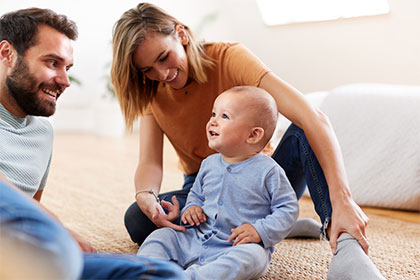The state supports families with children primarily by paying child benefit. There are also tax allowances for children that play a role in income tax assessment.

child benefit
Child benefit is paid from the month of birth and must be requested from the responsible family fund. For the first and second child in 2016 there are 190 euros each, for the third child it is 196 euros and from the fourth child the family fund pays 221 euros. From January 2017, all amounts will increase by two euros each. The family coffers make the increase automatically.
The amount of child benefit is positively influenced by the so-called counting children regulation. Zählkinder are children for whom no child benefit is paid, but who are taken into account in the ranking of a paying child.
Example: Spouses have their first child together. The father already has two other children from a previous relationship, but they live in the mother’s household.
The couple should designate the father as a child benefit beneficiary. Although he does not receive child benefit for the two children from the previous relationship, they count for him as counting children. For him, the child is the third child and there is six euros more child benefit.
Child allowances
The allowances for children have while not too important of the year. The tax-free allowances only have an effect on the income tax assessment, i.e. when the tax return is processed. The registry office records the birth of a child in the electronic ELStAM database. The tax-free allowances only affect the amount of the additional taxes, i.e. the solidarity surcharge and the church tax.
There are two allowances:
• Exemption for the neuter subsistence level
• Exemption for childcare, education and training needs
In 2016, the allowances for both parents total 7,248 euros. From 2017, the allowance for the actual subsistence minimum will be increased by 108 euros, so that the total amount will then rise to 7,356 euros.
In the income tax assessment, the tax office conducts a cheap check. If the tax relief for child allowances is higher than the child benefit received, the allowances are deducted from income to determine the tax; the child benefit received is added to the reduced income tax. The tax office only pays the difference with the tax assessment.
Especially parents with higher income benefit from the cheaper test.
Tip: Submit an "attachment child" for each child with the income tax return. Only then can the tax office carry out the cheaper check and take the children into account when calculating the additional taxes.
RELATED ITEMS
-

Child allowance or child benefit – cheaper examination
Child tax allowance check The child tax allowance is an amount for tax purposes related to the taxation of the income of the…
-

Child benefit and child allowance: an important change in the law when examining prices
To the delight of many families, child benefit increased on July 1, 2019. The child allowance was also raised again this year. And there are…
-

Child benefit 2020 – how much is child benefit?
The amount of child benefit depends on the number of children living in the family. The amount of child benefit increases from the third child. For…
-

Counting children – the benefit of counting children with child benefit
Child benefit for children Child benefit – Photo © yanlev, Fotolia.com Especially in connection with separated parents and the…
